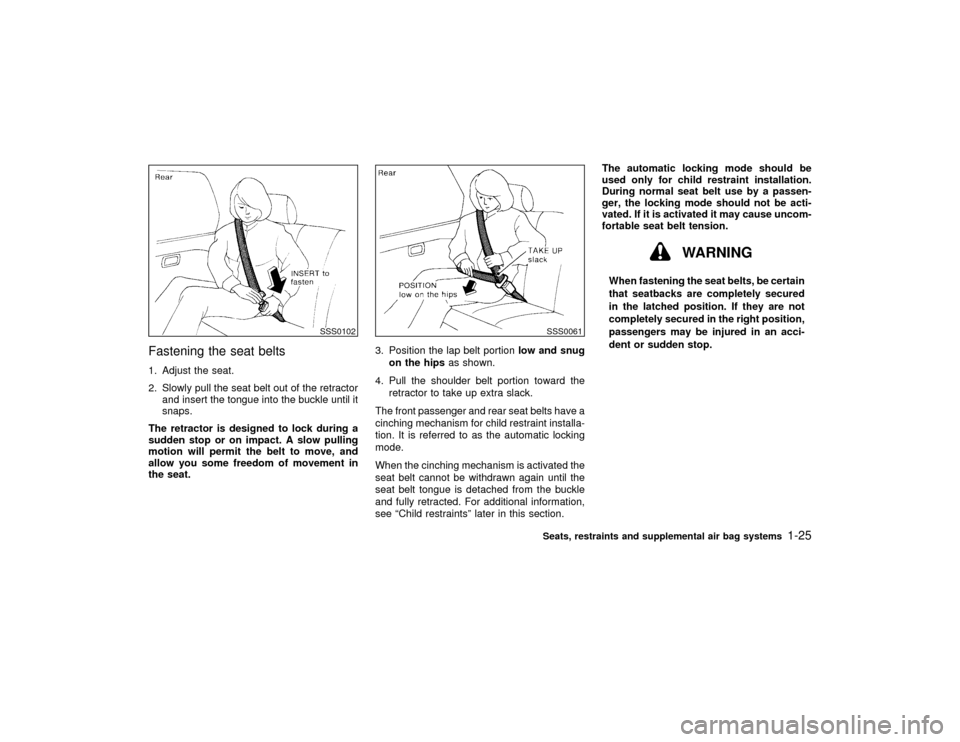child seat NISSAN MAXIMA 2000 A33 / 5.G Owners Manual
[x] Cancel search | Manufacturer: NISSAN, Model Year: 2000, Model line: MAXIMA, Model: NISSAN MAXIMA 2000 A33 / 5.GPages: 239, PDF Size: 1.97 MB
Page 1 of 239

ForewordWelcome to the growing family of new
NISSAN owners. This vehicle is delivered to
you with confidence. It was produced using
the latest techniques and strict quality control.
This manual was prepared to help you under-
stand the operation and maintenance of your
vehicle so that you may enjoy many miles of
driving pleasure. Please read through this
manual before operating your vehicle.
A separate Warranty Information and Main-
tenance Log Booklet (in U.S.), Warranty
and Roadside Assistance Information
booklet (in Canada) explains details about
the warranties covering your vehicle and
vehicle maintenance schedules. Addition-
ally, a separate Customer Care/Lemon Law
Booklet (U.S. only) will explain how to
resolve any concerns you may have with
your vehicle, as well as clarify your rights
under your state's lemon law.
Your NISSAN dealer knows your vehicle best.
When you require any service or have any
questions, he will be glad to assist you with
the extensive resources available to him.READ FIRST Ð THEN DRIVE
SAFELYBefore driving your vehicle please read
your Owner's Manual carefully. This will
ensure familiarity with controls and main-tenance requirements, assisting you in the
safe operation of your vehicle.
WARNING
IMPORTANT SAFETY INFORMA-
TION
REMINDERS FOR SAFETY!Follow these important driving rules to
help ensure a safe and comfortable trip
for you and your passengers!
INever drive under the influence of al-
cohol or drugs.
IAlways observe posted speed limits
and never drive too fast for condi-
tions.
IAlways use your seat belts and appro-
priate child restraint systems. Preteen
children should be seated in the rear
seat.
IAlways provide information about the
proper use of vehicle safety features
to all occupants of the vehicle.
IAlways review this Owner's Manual
for important safety information.
MODIFICATION OF YOUR
VEHICLEThis vehicle should not be modified. Modi-
fication could affect its performance,
safety or durability, and may even violate
governmental regulations. In addition,
damage or performance problems result-
ing from modification may not be covered
under NISSAN warranties.WHEN READING THE MANUALThis manual includes information for all
options available on this model. Therefore,
you may find some information that does
not apply to your vehicle.
All information, specifications and illustrations
in this manual are those in effect at the time of
printing. NISSAN reserves the right to change
specifications or design at any time without
notice.
Z
00.1.17/A33-D/V5.0
X
Page 6 of 239

1 Seats, restraints and supplemental air bag
systemsSeats ......................................................................... 1-2
Front manual seat adjustment .................................. 1-2
Front power seat adjustment .................................... 1-4
Folding rear seat ...................................................... 1-6
Head restraint adjustment ......................................... 1-7
Armrest ...................................................................... 1-8
Supplemental restraint system .................................. 1-8
Precautions on supplemental restraint system ......... 1-8
Supplemental air bag warning labels ...................... 1-18
Supplemental air bag warning light......................... 1-19
Seat belts ................................................................ 1-20
Precautions on seat belt usage .............................. 1-20Child safety ............................................................. 1-22
Pregnant women ..................................................... 1-23
Injured persons ....................................................... 1-24
Three-point type seat belt with retractor ................. 1-24
Seat belt extenders ................................................. 1-27
Seat belt maintenance ............................................ 1-27
Child restraints ........................................................ 1-28
Precautions on child restraints ................................ 1-28
Installation on rear seat outboard or center
positions .................................................................. 1-30
Top tether strap child restraint (if so equipped)...... 1-35
Installation on front passenger seat ........................ 1-36
Z
00.1.17/A33-D/V5.0
X
Page 9 of 239

Lumbar support (Driver's seat)The lumbar support feature provides lower
back support to the driver. Move the lever up
or down to adjust the seat lumbar area.
FRONT POWER SEAT
ADJUSTMENT
WARNING
IDo not adjust the driver's seat while
driving so full attention may be given
to vehicle operation.
IDo not leave children unattended in-
side the vehicle. They could unknow-
ingly activate switches or controls.
Unattended children could become
involved in serious accidents.Operating tipsIThe motor has an auto-reset overload pro-
tection circuit. If the motor stops during
operation, wait 30 seconds, then reactivate
the switch.
IDo not operate the power support seat
for a long period of time when the engine is
off. This will discharge the battery.
SPA0467
1-4
Seats, restraints and supplemental air bag systems
Z
00.1.17/A33-D/V5.0
X
Page 12 of 239

IClosely supervise children when they
are around cars to prevent them from
playing and becoming locked in the
trunk where they could be seriously
injured. Keep the car locked with the
rear seatback securely latched when
not in use, and prevent children's
access to car keys.
HEAD RESTRAINT ADJUSTMENTTo raise the head restraint, just pull it up. To
lower, push the lock knob and push the head
restraint down.
WARNING
Head restraints should be adjusted
properly as they may provide significant
protection against injury in an accident.
Do not remove them. Check the adjust-ment after someone else uses the seat.
SSS0125Seats, restraints and supplemental air bag systems
1-7
Z
00.1.17/A33-D/V5.0
X
Page 17 of 239

WARNING
INever let children ride unrestrained
or extend their hands or face out of
the window. Do not attempt to hold
them in your lap or arms. Some ex-
amples of dangerous riding positions
are shown in the previous illustra-
tions.
IChildren may be severely injured or
killed when the supplemental front air
bag or supplemental side air bag in-
flates if they are not properly re-
strained.
IAlso never install a rear facing child
restraint in the front seat. An inflating
supplemental front air bag could se-
riously injure or kill your child. For
additional information, see ªChild re-
straintsº later in this section.
WARNING
Supplemental side air bag (if so
equipped):
IThe supplemental side air bag ordi-
narily will not inflate in the event of a
frontal impact, rear impact or lower
severity side collision. Always wear
your seat belts to help reduce the risk
or severity of injury in various kinds
of accidents.IThe seat belts and the supplemental
side air bag are most effective when
you are sitting well back and upright
in the seat. The side air bag inflates
with great force. Do not allow anyone
to place their hand, leg or face near
the side air bag on the side of the
seatback of the front seat. Do not
allow anyone sitting in the front seat
to extend their hand out of the win-
dow or lean against the door. Some
examples of dangerous riding posi-
tions are shown in the previous illus-
SSS0101
SSS0140
1-12
Seats, restraints and supplemental air bag systems
Z
00.1.17/A33-D/V5.0
X
Page 18 of 239

trations.
IWhen sitting in the rear seat, do not
hold onto the seatback of the front
seat. If the supplemental side air bag
inflates, the occupant may be seri-
ously injured. Be especially careful
with children, who should always be
properly restrained.
IDo not use seat covers on the front
seatbacks. They may interfere with
supplemental side air bag inflation.
SSS0159
SSS0162Seats, restraints and supplemental air bag systems
1-13
Z
00.1.17/A33-D/V5.0
X
Page 26 of 239

WARNING
IEvery person who drives or rides in
this vehicle should use a seat belt at
all times. Children should be properly
restrained and, if appropriate, in a
child restraint.
IThe belt should be properly adjusted
to a snug fit. Failure to do so may
reduce the effectiveness of the entire
restraint system and increase thechance or severity of injury in an
accident. Serious injury or death can
occur if the seat belt is not worn
properly.
IAlways route the shoulder belt over
your shoulder and across your chest.
Never run the belt behind your back
under your arm or across your neck.
The belt should be away from your
face and neck, but not falling off your
shoulder.IPosition the lap belt as low and snug
as possible around the hips, not the
waist. A lap belt worn too high could
increase the risk of internal injuries in
an accident.
IBe sure the seat belt tongue is se-
curely fastened to the proper buckle.
IDo not wear the belt inside out or
twisted. Doing so may reduce its ef-
fectiveness.
IDo not allow more than one person to
use the same belt.
INever carry more people in the ve-
hicle than there are seat belts.
IIf the seat belt warning light glows
continuously while the ignition is
turned ON with all doors closed and
all seat belts fastened, it may indicate
a malfunction in the system. Have the
system checked by your NISSAN
dealer.
IOnce the pre-tensioner seat belt has
activated, it cannot be reused and
SSS0134Seats, restraints and supplemental air bag systems
1-21
Z
00.1.17/A33-D/V5.0
X
Page 27 of 239

must be replaced together with the
retractor. See your NISSAN dealer.
IRemoval and installation of the pre-
tensioner seat belt system compo-
nents should be done by an autho-
rized NISSAN dealer.
IAll seat belt assemblies including re-
tractors and attaching hardware
should be inspected after any colli-
sion by your NISSAN dealer. NISSAN
recommends that all seat belt assem-
blies in use during a collision bereplaced unless the collision was mi-
nor and the belts show no damage
and continue to operate properly.
Seat belt assemblies not in use dur-
ing a collision should also be in-
spected and replaced if either dam-
age or improper operation is noted.
CHILD SAFETYChildren need adults to help protect them.
They need to be properly restrained.
The proper restraint depends on the child's
size. Generally, infants (up to about 1 year and
less than 20 lb (9 kg) should be placed in rear
facing child restraints. Front facing child re-
straints are available for children who outgrow
rear facing child restraints.
SSS0136
SSS0016
1-22
Seats, restraints and supplemental air bag systems
Z
00.1.17/A33-D/V5.0
X
Page 28 of 239

WARNING
Infants and children need special pro-
tection. The vehicle's seat belts may not
fit them properly. The shoulder belt may
come too close to the face or neck. The
lap belt may not fit over their small hip
bones. In an accident, an improperly
fitting seat belt could cause serious or
fatal injury. Always use appropriate child
restraints.All US states and provinces of Canada require
the use of approved child restraints for infants
and small children. (See ªChild restraintsº later
in this section.)
In addition, there are many types of child
restraints available for larger children which
should be used for maximum protection.
NISSAN recommends that all preteens and
children be restrained in the rear seat if
possible. According to accident statistics,
children are safer when properly restrained
in the rear seat than in the front seat.
This is especially important because your
vehicle has a supplemental restraint sys-
tem (air bag system) for the front passen-
ger (see ªSupplemental Restraint Systemº
earlier in this section for precautions).
Infants and small childrenNISSAN recommends that infants and small
children be placed in child restraints that com-
ply with Federal Motor Vehicle Safety Stan-
dards or Canadian Motor Vehicle Safety Stan-
dards. You should choose a child restraint that
fits your vehicle and always follow the manu-
facturer's instructions for installation and use.Larger childrenChildren who are too large for child restraintsystems should be seated and restrained by
the seat belts which are provided.
If the child's seating position has a shoulder
belt that fits close to the face or neck, the use
of a booster seat (commercially available) may
help overcome this. The booster seat should
raise the child so that the shoulder belt is
properly positioned across the top, middle
portion of the shoulder and the lap belt is low
on the hips. The booster seat should fit the
vehicle seat and have a label certifying that it
complies with Federal Motor Vehicle Safety
Standards or Canadian Motor Vehicle Safety
Standards. Once the child has grown so the
shoulder belt is no longer on or near the face
and neck, use the shoulder belt without the
booster seat.
WARNING
Never let a child stand or kneel on any
seat and do not allow a child in the cargo
areas while the vehicle is moving. The
child could be seriously injured or killed
in an accident or a sudden stop.PREGNANT WOMENNISSAN recommends that pregnant women
SSS0014
Seats, restraints and supplemental air bag systems
1-23
Z
00.1.17/A33-D/V5.0
X
Page 30 of 239

Fastening the seat belts1. Adjust the seat.
2. Slowly pull the seat belt out of the retractor
and insert the tongue into the buckle until it
snaps.
The retractor is designed to lock during a
sudden stop or on impact. A slow pulling
motion will permit the belt to move, and
allow you some freedom of movement in
the seat.3. Position the lap belt portionlow and snug
on the hipsas shown.
4. Pull the shoulder belt portion toward the
retractor to take up extra slack.
The front passenger and rear seat belts have a
cinching mechanism for child restraint installa-
tion. It is referred to as the automatic locking
mode.
When the cinching mechanism is activated the
seat belt cannot be withdrawn again until the
seat belt tongue is detached from the buckle
and fully retracted. For additional information,
see ªChild restraintsº later in this section.The automatic locking mode should be
used only for child restraint installation.
During normal seat belt use by a passen-
ger, the locking mode should not be acti-
vated. If it is activated it may cause uncom-
fortable seat belt tension.
WARNING
When fastening the seat belts, be certain
that seatbacks are completely secured
in the latched position. If they are not
completely secured in the right position,
passengers may be injured in an acci-
dent or sudden stop.
SSS0102
SSS0061Seats, restraints and supplemental air bag systems
1-25
Z
00.1.17/A33-D/V5.0
X